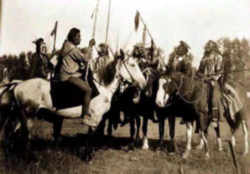


California Symbols
California Early History
First Early Inhabitants of California

Early history examines the archaeological record that tells the story of the first inhabitants of California. Learn about the prehistory and culture of the first early inhabitants, and what lessons it might teach us about the early history of California.
California First Early Inhabitants Timeline
- Cretaceous (145.5 - 65.5 million years ago) Estimates are still uncertain, but researchers now think that the first grasses arose at least 80 million years ago and began diversifying before India lost its connections with Africa and South America. Grasses found in fossilized dinosaur scat suggest that grasses may have first evolved in tandem with herbivorous dinosaurs.
- Pliocene (5.3 - 2.58 million years ago) Grass pollen first appears in California's fossil record and become widespread on broad wet coastal plains. The Coast Ranges (and other California mountain ranges) begin a major period of uplift (lasting from 5 to 1.6 million years ago) that creates a diversity of coastal, inland, and high elevation climates where grasses thrive.
- Pleistocene (2.58 Million - 12 Thousand years ago) California undergoes dramatic changes in climate and geology that diversifies
grassland environments. Mediterranean climate (dry summers and wet winters) is established in California with the arrival of cold off-shore currents.
Uplift of the Coast Ranges (and other California mountain ranges) continues. Step-like coastal terrace prairies, a principal home for California's
coastal prairies, are created by changing sea levels. Coastal terrace prairies are estimated to be 80,000 to 600,000 years old.
Grassland species diversity reaches astonishingly high levels. By the late Pleistocene (1.5 million years ago to 12,000 years ago), California grasslands supported one of the greatest wildlife assemblages on the Earth. The diversity and abundance of pre-historic grazers, browsers, predators, and scavengers may be one of the greatest in the world exceeding that of East Africa. Many native Californian annual and perennial forbs diversified during this period. Mammoths may have been key agents in maintaining grassland biomes, converting forests to grasslands by destroying trees, and possibly creating vernal pools by wallowing. - 25,000- 10,000 BP - Peoples of north-east Asia followed herds of Caribou, bison, and mammoth across the present day Bering Strait. Then moved south along ice-free corridors into the American continents.
- 13,000 BP - Date of Arlington Springs Woman, found on the islands in recent digs.
- 12,500 BP - Santa Barbara Channel Islands were settled; fire-reddened earth from more than a hundred fire sites date from this period.
- 10,000 BP - Local population of dwarf mammoth went extinct; teeth found charred by fire.
- 9,000 BP - In 1914, the remains of a young woman were uncovered at the Rancho La Brea tar pits, the only prehistoric human remains found at the site. Her skull and partial skeleton is preserved in The Page Museum at the La Brea Tar Pits. Also the likely date of Los Angeles Man, excavated in 1936. The mineralized cranium of his skull was discovered in the Ballona Creek in West Los Angeles (cf. Altschul et al., 1992).
- 8,000 BP - Settlement of the Southern California Coast by Chumash. A village in Glen Annie carbon dated to 7,300 BP.
- 5,000 BP - Settled villages near estuaries, with large middens.
- 2,000 BP - Very large coastal villages; fewer people in the interior and on the islands. Evidence of alliances and warfare.
- 200-500 AD - Continental drought provokes wide-ranging migrations. The Tongva, or Gabrielinos, who speak Shoson, a Uto-Aztec language, come down from the Mojave and settle in the Los Angeles basin, displacing the Hokan speakers, relatives of the Chumash.
- 458 AD - Chinese's records speak of the explorer Hui Shan, who in 458 AD sailed the Pacific and may have reached the coast of California. Hui Shan noted tall trees with a red wood.
- 1000 AD - Woodland period with permanent houses and farming
- 1535 - Hernando Cortés explores La Paz
Early History of Native Americans in California
The Indigenous People of California
The names of the California tribes included the Chilula, Cocopah, Hoopa (aka Hupa), Juaneno, Karok, Kato, Konkow, Mohave Miwok, Modoc, Pomo, Shoshoni tribe aka Shoshone, Wintu and Wiyot.
California's earliest inhabitants were Asians who traveled the Bering Strait into North America using a now-vanished land bridge. More than 10,000
years ago, they settled throughout the region's diverse geographic areas and climates. Deserts and high mountains helped to separate these groups,
and they lived peacefully in relative isolation from one another. Over many years, distinctive differences in lifestyle and culture developed among
these groups, which included the Hupa, the Maidu, the Pomo, the Modic, and the Mohave tribes. More than 135 language dialects emerged.
Due to a rather dry growing season, these tribes did not develop agricultural societies. Instead, they became very skillful gatherers of native roots,
nuts and berries. They also fished in the plentiful lakes and streams. Because of an absence of warfare, a favorable climate, and a plentiful food
supply, these cultures flourished.
When Europeans entered the California region in the 16th century, they encountered a population of more than 300,000 Native Americans in more than
200 tribes. Their centuries-old way of life was brought to an end relatively quickly: native Californians soon established regular trading relationships
with the Spanish, increasing coastal groups' power and prestige, giving them greater leverage in dealings with inland groups.
But Native Californians were not immune to Old World diseases. Smallpox, influenza, dysentery, malaria, measles, and syphilis spread from group to group. By 1848, such diseases had reduced California's native population by more than two-thirds. This catastrophic decline disrupted families, communities, and trading networks, weakening native resistance to Spanish, Mexican, and American intrusion.





